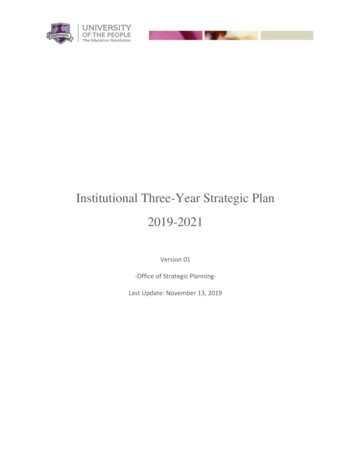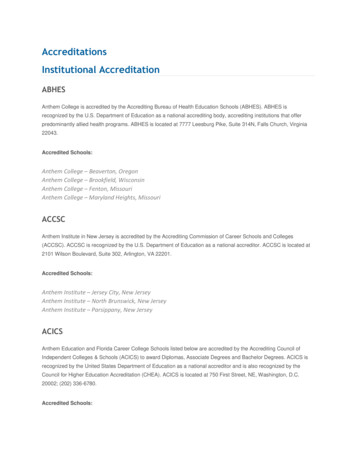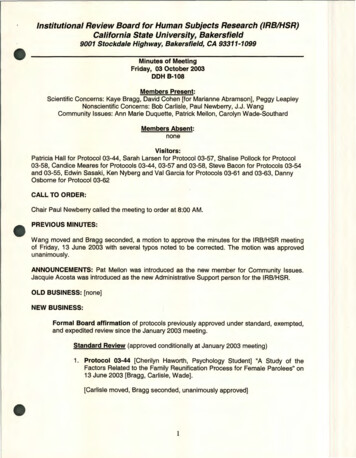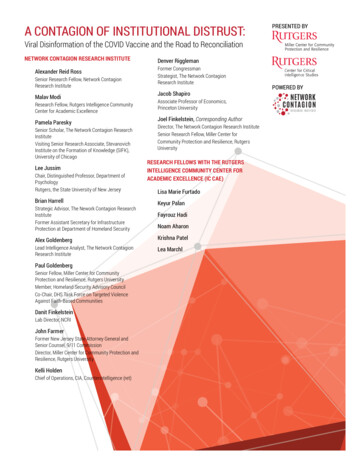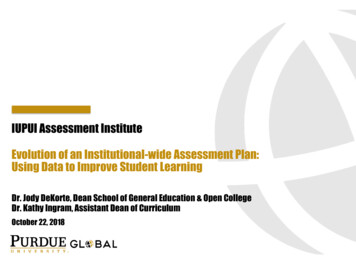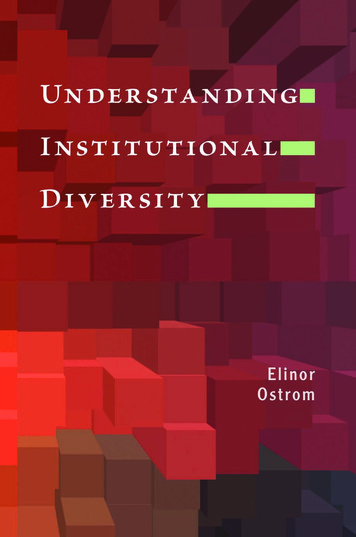
Transcription
UNDERSTANDING INSTITUTIONAL DIVERSITY
UNDERSTANDING INSTITUTIONALDIVERSITYElinor OstromPRINCETON UNIVERSITY PRESSPRINCETON AND OXFORD
Copyright 2005 by Princeton University PressPublished by Princeton University Press, 41 William Street,Princeton, New Jersey 08540In the United Kingdom: Princeton University Press,3 Market Place, Woodstock, Oxfordshire OX20 1SYAll Rights ReservedLibrary of Congress Cataloging-in-Publication DataOstrom, Elinor.Understanding institutional diversity / Elinor Ostrom.p. cm.Includes bibliographical references and index.ISBN-13: 978-0-691-12207-6 (cloth : alk. paper)ISBN-10: 0-691-12207-5 (cloth : alk. paper)ISBN-13: 978-0-691-12238-0 (pbk. : alk. paper)ISBN-10: 0-691-12238-5 (pbk. : alk. paper)1. Diversity in the workplace. 2. Multiculturalism. 3. Interpersonalrelations. 4. Organizational behavior. 5. Social norms. I. British Library Cataloging-in-Publication Data is availableThis book has been composed in SabonPrinted on acid-free paper. pup.princeton.eduPrinted in the United States of America10 9 8 7 6 5 4 3 2 1
To the fabulous colleagues, students, visiting scholars,and staff who have made scholarship at the Workshopover the past thirty years highly productive, challenging,and rewarding
ContentsList of IllustrationsxiAcknowledgmentsxiiiPART I: AN OVERVIEW OF THE INSTITUTIONAL ANALYSISAND DEVELOPMENT (IAD) FRAMEWORK1OneUnderstanding the Diversity of Structured Human Interactions3Diversity: A Core Problem in Understanding InstitutionsIs There an Underlying Set of Universal Building Blocks?Holons: Nested Part-Whole Units of AnalysisAction Arenas as Focal Units of AnalysisZooming Out to an Overview of the IAD FrameworkViewing Action Arenas as Dependent VariablesInstitutional Frameworks, Theories, and ModelsThe Limited Frame of This Book45111315162729TwoZooming In and Linking Action SituationsAn Action Situation as a Focal Unit of AnalysisExample of a Simple Action SituationThe Basic Working Parts of Action SituationsLinking Action ArenasPredicting OutcomesEvaluating OutcomesThreeStudying Action Situations in the LabThe Trust Game in the Experimental LaboratoryA Commons Dilemma in the Experimental LaboratoryStructural Changes in the LaboratoryReplications and Extensions of Commons DilemmaExperimentsConclusionsFourAnimating Institutional AnalysisAnimating Open, Competitive Processes3232353755646669707885939799100
viiiCONTENTSThe Challenge of Imperfect InformationAssumptions Used in Animating ParticipantsVariety and Complexity: An Asset or a Liability?A Focus on Collective Action to Overcome Social DilemmasNorms Fostering Collective ActionEmergence and Survival of Norms in Evolutionary ProcessesConclusion101103116119121125131PART II: FOCUSING ON RULES135FiveA Grammar of Institutions, Sue Crawford and Elinor OstromParsing Institutional StatementsThe Syntax of a Grammar of InstitutionsThe Syntax ComponentsApplying the GrammarUsing the Grammar in Empirical Field ResearchSome Next Steps137137139140152171173SixWhy Classify Generic Rules?Solving Babbling Equilibrium ProblemsThe Policy Analyst’s Need to Understand How toReform SituationsMoving beyond Slogan Words to Describe InstitutionsCoping with the Immense Diversity by IdentifyingGeneric RulesThe Role of Rules as Information TransformationMechanismsAn Underlying Universality?SevenClassifying Rules, Elinor Ostrom and Sue CrawfordThe Horizontal Approach: Classifying by the AIM of a RulePosition RulesBoundary RulesChoice RulesAggregation RulesInformation RulesPayoff RulesScope RulesDefault Conditions: What Happens if No Rules ExistRelated to Components of an Action 06207208210
CONTENTSThe Vertical Approach: Operational, Collective-Choice,and Constitutional-Choice Levels of AnalysisUsing Rules as Tools to Change Outcomesix214215PART III: WORKING WITH RULES217EightUsing Rules as Tools to Cope with the Commons219Field Research on Common-Pool ResourcesWhat Rules Are Found in Self-Organized Common-PoolResource Regimes?Contemporary Approaches to Resource PolicyCoping with Complexity: A General ProblemChanging Rules as an Adaptive ProcessTheoretical PuzzlesSumming UpNineRobust Resource Governance in Polycentric InstitutionsDesign Principles and Robust Social-Ecological SystemsThreats to Robust Governance of Common-Pool ResourcesModest Coping Methods for Dealing with Threats toSustainabilityThe Advantage and Limits of Polycentric Systems in Copingwith Design and Long-Term Sustainability of SystemsThe Capabilities of Polycentric Systems in Coping withTragedies of the 281283287Notes289References307Index351
4.24.35.15.25.35.45.55.67.17.2The focal level of analysis—an action arenaA framework for institutional analysisFour basic types of goodsThe internal structure of an action situationThe Snatch GameLevels of analysis and outcomesRelationships of formal and informal collective-choice arenasThe Trust GameTrust and reciprocity under three experimental conditionsThe relationship between information, action-outcomelinkages, and internal mental modelsThe impact of communication, vividness, and salience onthe relationship between information, action-outcomelinkages, and internal mental modelsThe Snatch Game with normsAuthorized relationships: authority to actBase gameRepeated game with shared strategiesGame with a norm and monitoringEquilibrium diagram: game with a norm and monitoringGame with a ruleRules as exogenous variables directly affecting the elementsof an action situationThe Snatch Game with minimal property 3189213Tables2.1 Action sets assigned to positions in several “typical” actionsituations2.2 Results if collective-choice rules specify that a tie voteretains the status quo2.3 Results if collective-choice rules specify that a tie vote leadsto a change3.1 Summary results across environments4.1 Description of various decision strategies46474790115
xiiI L L U S T R AT I O N S5.1 Game summaries5.2 Delta parameters and normative concepts used in recentliterature6.1 Shared strategies, norms, and rules as used in ADICO syntaxand in recent literature7.1 The AIM component of each type of rule7.2 Default conditions7.3 Rules changed to create elementary property rights foragricultural commodities8.1 Attributes and conditions used in boundary rules to definewho is authorized to appropriate from a common-poolresource8.2 Choice rules used to allocate common-pool resources8.3 Water allocation rules in Chitwan and Tanahun districts155169178191211212224229232
AcknowledgmentsANY BOOK DRAWING on unpublished and published papers that an authorhas drafted and thought about for multiple decades requires many acknowledgments. As I mention in several places in the volume, sections ofthis book were started in the 1980s when I was a research scholar at theCenter for Interdisciplinary Research at Bielefeld University in Germany.I was fortunate enough to visit Bielefeld during 1982 and again in 1988.The opportunity to express some of my early thinking about nested sets ofrules and action situations with colleagues participating in both Bielefeldgroups is deeply appreciated and helped me immensely. I can rememberthe puzzlement of several colleagues when I decided to entitle a lecturegiven at Bielefeld in 1982 “The Hidden Structure behind the Structure.”In some respects, one may think of this book as my effort to uncover thathidden structure and to answer their many questions.My major home base throughout this entire period, of course, has beenthe Workshop in Political Theory and Policy Analysis at Indiana University, Bloomington. Many earlier draft sections of what is now in this bookhave been presented at our colloquiums, at miniconference sessions, andin various working group meetings (e.g., the CPR Rules Coding Group,the Evolutionary Theory Working Group) at the Workshop. It has beenan intellectual home for me where one could present radical ideas and getthem taken seriously at the same time as they are being challenged anddebated. The support of the Workshop by Indiana University is deeplyappreciated.Vincent Ostrom cofounded the Workshop with me more than thirtyyears ago, and his ideas permeate all that we do at the Workshop. Noneof us could have achieved what we have done without his inspiration,criticism, encouragement, and help, and there is no way of really adequately thanking him for years of lively discussions about the theoreticalissues discussed in this book.Throughout this period, we have been fortunate to receive fundingfrom the National Science Foundation (SES-8619498; SES-8921888;SBR-9521918; SES-0083511), the Ford Foundation (950–1160–1), andthe MacArthur Foundation (00–63798-GSS). Work with colleagues inthe Resilience Alliance (supported by the McDonnell Foundation) hasproved important during recent years and has helped to stimulate workon the last sections of the book. I was fortunate to spend a month withcolleagues at the Max Planck Center for the Study of Common Goods inBonn, Germany, during 2001. The staff there was very helpful and as-
xivACKNOWLEDGMENTSsisted me in getting a number of notes that had been written in the 1980sinto text form.In recent years, I have given a number of seminars at different universities on various sections of this book. These include: the Sanford Schoolof Public Policy at Duke University in November 2001; the Departmentof Political Science, University of California, San Diego, in March 2002;as part of the Walker-Ames Lecture Series at the University of Washingtonin April 2002; Kathmandu University in April 2002; the Department ofEconomics and the Complex Systems Group at the University of Michigan in November 2002; the Max Planck Institute in Jena, Germany, inJune 2003; Purdue University in October 2004; Cornell University in November 2004; Case Western University in January 2005; and at the Workshop itself on October 18, 2004, as well as in my seminar during the fallsemesters of 2003 and 2004.During the many years that colleagues and I have been trying to understand institutions, the occasion to write a number of papers and chaptershave enabled coauthors and me to develop initial versions of many of thearguments in this volume. Thus, there are partial sections of earlier papersthat are drawn on in multiple chapters of this volume, including:Chapters 1 and 2: Elinor Ostrom, “Institutional Rational Choice: AnAssessment of the Institutional Analysis and Development Framework,”in Theories of the Policy Process, ed. Paul A. Sabatier (Boulder, CO: Westview Press, 1999), pp. 35–71; and Elinor Ostrom, “Doing InstitutionalAnalysis: Digging Deeper Than Markets and Hierarchies,” in the Handbook of New Institutional Economics, ed. Claude Ménard and Mary Shirley (Dordrecht, the Netherlands: Springer, 2005), pp. 797–926.Chapter 4: Elinor Ostrom, “Collective Action and the Evolution of Social Norms,” Journal of Economic Perspectives 14 (3) (2000): 137–58.Chapter 5: Sue E. S. Crawford and Elinor Ostrom, “A Grammar of Institutions,” American Political Science Review 89 (3) (September 1995): 582–600. (Reprinted with the permission of Cambridge University Press.) Reprinted in Polycentric Games and Institutions: Readings from the Workshop in Political Theory and Policy Analysis, ed. Michael McGinnis (AnnArbor: University of Michigan Press, 2000), pp. 114–55. Figures and tablesreprinted with the permission of the University of Michigan Press.Chapter 8: Elinor Ostrom, “Reformulating the Commons,” in Protecting the Commons: A Framework for Resource Management in theAmericas, ed. Joanna Burger, Elinor Ostrom, Richard B. Norgaard, DavidPolicansky, and Bernard D. Goldstein (Washington, D.C.: Island Press,2001), pp. 17–41.Chapters 8 and 9: Elinor Ostrom, “Coping with Tragedies of the Commons,” Annual Review of Political Science 2 (1999): 493–535. (Reprinted with permission of the Annual Review of Political Science.)
ACKNOWLEDGMENTSxvChapter 9: Elinor Ostrom, “Institutional Analysis, Design Principles,and Threats to Sustainable Community Governance and Management ofCommons,” in Law and the Governance of Renewable Resources: Studies from Northern Europe and Africa, ed. Erling Berge and Nils ChristianStenseth (Oakland, CA: ICS Press, 1998), pp. 27–53.As I work on this book, I am deeply appreciative of the long conversations that I have had with colleagues about the Institutional Analysis andDevelopment (IAD) framework, which many of us have had a direct rolein creating. The many conversations and memos shared with Larry Kiserand Sue Crawford are particularly important in affecting my own thinking, and working with Roy Gardner and James Walker to model theseideas using game theory and build experimental games to test our predictions has been invaluable. Roger Parks has repeatedly given me extensivecomments on earlier manuscripts that have challenged me to work stillharder to explain the concepts. Marco Janssen and Mike McGinnis haveboth read and commented extensively on sections of this manuscript.Working with T. K. Ahn on multiple papers has also added to my understanding. Chuck Myers at Princeton University Press has given me manyuseful suggestions and has been extremely helpful through the final yearof moving an amorphous manuscript toward being a real book. CindyCrumrine, who copyedited this book for Princeton University Press, didan outstanding job. The anonymous reviewers for Princeton UniversityPress also provided useful advice. Eric Coleman has read through the finaldraft with a critical and useful eye and developed the index for this book.Without Patty Lezotte’s excellent editing skills, thoughtful insights, andcheerful help under high stress, I do not know how I could have finishedthis book.In addition, there have been a number of people who have given oneor more c
Understanding the Diversity of Structured Human Interactions 3 Diversity: A Core Problem in Understanding Institutions 4 Is There an Underlying Set of Universal Building Blocks? 5 Holons: Nested Part-Whole Units of Analysis 11 Action Arenas as Focal Units of Analysis 13 Zooming Out to an Overview of the IAD Framework 15 Viewing Action Arenas as Dependent Variables 16 Institutional Frameworks .




